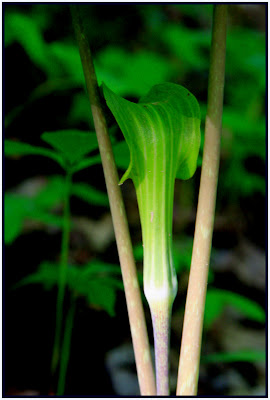Scientific name: Arisaema triphyllum
Description:
Erect, unbranching, smooth perennial, 1-3 feet tall.
An upright, rigid, curved spathe enveloping an erect, club-shaped spadix beneath large leaves.
Other Names:
Indian turnip, wild turnip, marsh pepper, bog-onion, brown dragon, starchwort, wake robin, dragon-root, cuckoo-pint.
Spadix: (the "Jack") slenderly club-shaped (2-3" tall)
Spathe: (the "pulpit" and "canopy") tubular below, shallowly corrugated with a narrow flange above, becoming expanded and arching over the spadix. Streaked or mottled; greenish or purple to bronze with pale greenish stripes (quite variable in coloration and markings).
Leaves: Usually two, long-stalked, tri-foliate (3-parted), pinnate veination, deep green.
Flowering: April to June (in Michigan)
Reproduction:
The flowers are usually unisexual, but are hidden from view at the base of the spadix. You can't tell male from female without prying open the pulpit base to examine the spadix. The insect-pollinated flower produces no nectar. The spadix base produces a fungus-like odor that certain insects find irresistible. The rest of the reproduction story is seriously complex, so let's give it a rest. Just know that Jack-in-the-Pulpit adapts its size, coloration and sex to environmental circumstances.
Fruit: Bright scarlet and shiny berries clustered on spadix. Fruiting late summer to fall. A low-quality wildlife food consumed by Wild Turkeys and Wood Thrushes.
Habitat: Damp woods and moist thickets. Often near swamps.
Etymology:
The name "Jack-in-the-Pulpit" was originated by a clerical-minded New Englander, Clara Smith, from Medford, Massachusetts. She sent a "flowery" verse to poet John Greenleaf Whittier for his approval. He tinkered with it, finally publishing it under his own famous name about 1884. Thus "Jack" suddenly became a good (if somewhat plagiarized) New England Calvinist flower.
Weaving words of grace and gratitude through the fabric of my photography, I wish to share the everyday miracles of God's creation. Writing with a blend of curiosity, discovery, and spirituality, I invite the reader-viewer along a trail of words and images; thoughtfully selected and graciously given.










Very nice!
ReplyDeleteAnn Marie:
ReplyDeleteThanks again for your loyal following. I hope you learned something about "Jack", like I always do when doing Botanical research.
Rich